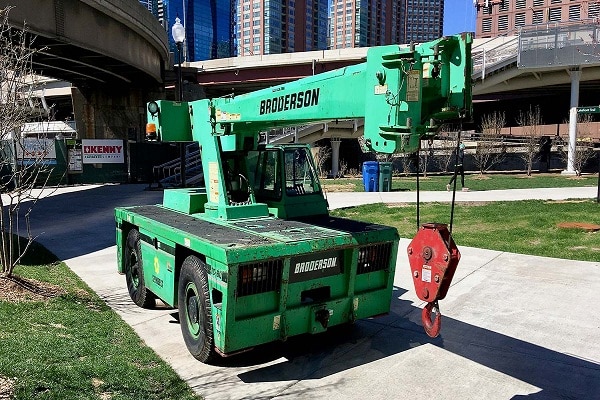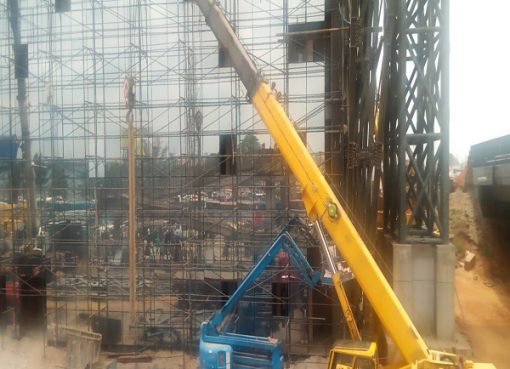Every construction project has a perfect set of machinery to get the job done. Getting the right equipment for each project helps with efficiency, safety and build quality. Because of this, it’s essential to be on the same page with your team when it comes to choosing equipment. Some machines have multiple uses, while others are task-specific.
So, if you are interested in construction, here are 25 construction equipment names you need to know:
1. Boom Lift

A boom lift is a type of aerial platform used to get workers off the ground to work on an elevated project. This construction lift has a bucket that’s typically large enough for one to two workers to stand in. Wheels or a continuous band of treads are used to make the machine mobile. The crane that lifts the bucket is operated by a hydraulic lift system.
There are two main types of boom lifts: articulating and telescopic, but these are all part of the larger “construction lift” family.
2. Scissor Lift

Similar to a boom lift, scissor lifts are aerial work platforms used to elevate workers. Both electric and engine-powered scissor lifts exist. Electric scissor lifts are used when a quieter work environment is needed, whereas engine-powered lifts sacrifice quiet for rugged terrain mobility. Scissor lift buckets are elevated by a system of jacks.
3. Forklift

If materials need to be transported a short distance, forklift equipment can be used. The lift can move materials both vertically and horizontally. Usually used in warehouses, it’s operated by a steering wheel and dashboard controls. This equipment is great for loading and unloading heavy packages/materials.
There are ten main forklift types, each with a specific use. For instance, the reach forklift is used to “reach” boxes and other objects at extremely high heights within a warehouse.
4. Manlift

The manlift was created to transport workers between floors of buildings under construction. Typically, manlifts are equipped with four wheels, and most can maneuver around sites. However, these machines are sometimes stationary and have to be moved on a trailer.
Manlifts utilize a bent crane system that uses hydraulic pumps to raise a bucket that workers stand-in during transport. This construction lift is ideal for any project that needs to reach high elevations.
5. Telehandlers

A telehandler is used for jobs where a forklift is inadequate. It’s more heavy-duty than a forklift and can access much higher areas as well.
These pieces of heavy equipment have an extendable arm, allowing them to place loads in high places. The machine also has large tires, giving it an advantage on off-road sites.
6. Bulldozer

Bulldozers are pieces of crawler equipment and have many different uses. Equipped with a metal bucket plate, this piece of heavy machinery is used to push, carry and condense any sort of loose material on site. The metal plate can also be used to loosen compacted materials and break apart walls or other stable structures.
7. Wheel Tractor-Scraper

Wheel tractor-scrapers are also used in earthmoving operations. This piece of heavy equipment consists of a rear hopper which can move vertically, with a sharp edge for flattening a surface. The front end hosts a sharp edge to cut soil and a carpenter’s plane for cutting wood. The two tools work together to fill the hopper and transport whatever material was removed from a cleared area.
8. Skid Steer Loader

Used for a plethora of jobs, a skid-steer loader is a small engine-powered machine. In front of the operating cabin, there’s a mechanism that allows for the attachment of different types of tools.
From buckets to loaders, a skid loader can host different equipment and is also small enough to maneuver into tight areas of a site. The frame is rigid, meaning turning is done through differential steering (e.g., each wheel moves at a different speed, thus causing a turn).
9. Backhoe Loader

Another type of digger is a backhoe loader. Equipped with a backhoe in the back and a bucket in front, this is a multi-use machine. Similar to a tractor, it’s operated by a driver and has the ability to push materials, with the additional benefit of scooping. Due to its small profile and high maneuverability, the backhoe loader (referred to as backhoe in the industry) is commonly seen in urban environments.
10. Excavator

An excavator is a heavy piece of machinery used to dig and crush material on a site. It consists of a hydraulic crane-like boom with a metal shovel that has sharp prongs on the end. The driver’s cab is set on a rotating platform, making the machine more maneuverable. The machine is mobile due to an undercarriage consisting of heavy-duty tracks. Although sometimes called a “power shovel,” an excavator and a power shovel have their differences.
11. Feller Buncher

Feller bunchers are a type of harvester that are required for logging. They consist of a standard four-wheel base, giving them easy access to off-road sites. A feller buncher gathers trees by wrapping multiple metal arms around a tree’s trunk and then snipping its base with a chainsaw. This type of harvester then carries the entire tree to a collection area where the greenery will be broken down by other machines.
12. Trencher

Trenchers are the perfect tool for digging ditches, channels or other long, narrow holes for things like underground piping and cables. This powerful tool is equipped with a heavy metal chain made with incredibly strong steel which it uses to cut into the ground and rip through things like roots, smaller rocks and dirt. They come in a range of sizes and capacities, like the wheel trencher or chain trencher, which looks like a giant chain saw.
13. Articulated Hauler

As with any articulated truck, an articulated hauler has a pivot joint in its build, giving it increased mobility. Because of this joint, it can carry massive loads around tight turns, making it ideal for most structural builds. This dump truck has a control hub where the driver sits and a material pail where loads go to be transported. Almost all articulated haulers are four-wheel drive, giving them access to most sites regardless of condition.
14. Off-Highway Truck

The off-highway truck is specifically made for rugged environments. This heavy-duty dump-truck has massive wheels with deep treads, allowing it to venture off-road and support construction and mining sites. It’s primarily used to transport materials like rocks or dirt from one site to another. Some models use multi-axle dump buckets to support even heavier loads.
15. Asphalt Paver

Machines used to lay asphalt are called asphalt pavers. Asphalt is loaded into the paver by a dump truck, and then distributed onto the desired area before being semi-packed down — then they are completely flattened by a roller. The paver is typically towed by a dump truck holding asphalt.
16. Cold Planer

A cold planer grinds asphalt, removing it from its original location. This machine drives down a space and picks up laid asphalt, mills it and then shoots it out a belt system into a dump truck.
These machines help get a surface ready for new asphalt and aid in the recycling efforts by recovering old asphalt. This machine is bulky and hard to maneuver, so it’s essential to get the machine’s placement right when starting a job to ensure minimal shifting while milling.
17. Motor Grader

A motor grader is essential to the process of building a road. This heavy machinery is one of the components that flattens an area of dirt in order to build a road. A grader ensures an even grade thanks to a metal plate that flattens the areas it passes over. It’s typically six-wheeled and has an elongated nose where the flattening metal plates sit.
18. Compactor

While there are many types of compactors in construction, the plate compactor is the most commonly used. It has a vibrating base plate that levels surfaces and crushes uneven debris. Another common compactor is a road rolling compactor.
Road rolling compactors are used to flatten roads in order to prepare them for re-asphalting or to lay foundation. Other common compactors found on construction sites are trash and hydraulic compactors.
19. Drum Roller

In order to press asphalt, soil and other loose materials, drum rollers are used. This machine is typically found at road construction sites. There are two types of drum rollers: smooth rollers and padfoot rollers.
Smooth rollers provide static pressure and use vibration to compact loose materials. Padfoot rollers, also known as Sheepsfoot rollers, also provide static pressure and vibration; however, they also generate manipulative force, allowing for uniform compaction.
20. Compact Track and Multi-Terrain Loader

A compact track loader (CTL) and multi-terrain loader (MLT) are small, compressed machines used to transport and load materials. Equipped with front metal plate scoops, both machines lift and break apart massive loads.
The difference between a CTL and an MTL is that a CTL is more rugged and puts immense pressure on the ground it’s on, so it’s best for tough terrain. The MTL is less rugged but is designed to work on more delicate surfaces.
21. Skidder

Skidders are also used in logging operations. These foresting machines cut and then move trees to a landing site where they will be loaded onto a vessel for transport. Unlike forwarders, which carry logs a few inches above the ground, skidders typically drag logs to a loading site.
22. Forwarder

The forwarder is also used in logging efforts — it takes felled logs and carries them to a loading site. Typically an eight-wheel truck, this machine is designed to go off-road into rugged terrain. The advantage of using this forestry vehicle over other machines is that it’s able to carry logs above the ground. This eliminates dragging, which can destroy the soil.
23. Knuckleboom Loader

The knuckleboom loader is designed to handle logs. Some models are more versatile than others — depending on their off-road ability. Knuckleboom loaders are equipped with tracks and more versatile than wheel or trailer-based models. Once a forwarder brings a log to a loading site, the knuckleboom loader will use a crane head to grab the wood and put it on a truck.
24. Towable Light Tower

A towable light tower is used to provide light during night projects or on sites without natural light. This machine is typically diesel-powered and can be taken off-road. It consists of a generator, which is attached to a pair of wheels, and the light tower itself.
25. Carry Deck Crane

A carry deck crane is a small, mobile crane system with a 360-degree rotating platform. This type of crane is ideal for projects that require lifting materials at nearby locations. The operating platform, or deck, sits on four wheels and has a control panel plus a steering wheel for operation.
Whatever your project entails, we hope that this has given you more direction in deciding what equipment you will need. It’s important to consider safety as well as efficiency when selecting the gear needed to complete your task.
Some of these machines are easier to come by than others, but BigRentz has everything from earthmoving equipment to carry deck cranes to help you get the job done right.
Source: bigrentz










